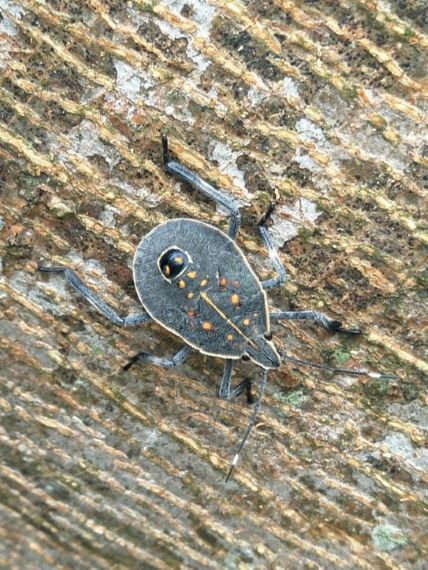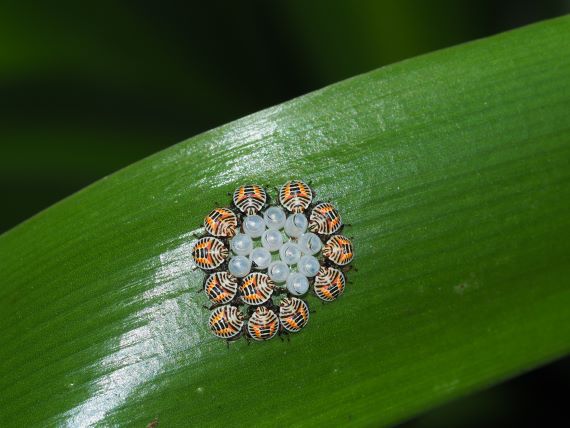
Yellow Spotted Stink Bug
| Primefact number | Edition | Published | Author |
|---|---|---|---|
| PUB24/18 | First | Jan 2024 | Plant Biosecurity and Product Integrity |
Yellow spotted stink bug (Erthesina fullo) is a plant pest which is not present in Australia. It is known to be a pest of several important economic crops, as well as ornamental and amenity trees. If it were it to become established, it would threaten Australia’s horticultural industries. It also has the potential to become a nuisance pest, with large groups of adults invading buildings and vehicles during the winter.
Pest status
Yellow spotted stink bug is an invasive species that is not known to occur in Australia (i.e. it is “exotic”).
Damage
Yellow spotted stink bugs are haustellate, with mouthparts formed into needle-like stylets used to penetrate and suck fluid from a plant’s vascular tissue, as well as rupturing plant cells to feed on the contents within. The damage is similar to that caused by other species of stink bug, with feeding resulting in discolouration, yellowish-brown spots, withering, and in severe cases defoliation.
Nymphs and adults of the yellow spotted stink bug feed on the leaves, flowers, shoots, and fruit of plants.
Lifecycle and behaviour
The yellow spotted stink bug has five nymphal instars before emerging as an adult.
Populations range from univoltine to multivoltine depending on climatic conditions, with up to three generations per year observed in some populations. In univoltine and bivoltine populations non-reproductive adults leave host plants in autumn, aggregating in large groups to overwinter. Overwintering adults typically seek sheltered areas, such as homes, containers, and vehicles. Overwintering adults will begin to disperse in spring, when temperatures exceed 13 °C.
They are primarily—though not exclusively—arboreal, preferring to inhabit trees during the day where they can be found resting on top of leaves and fruit. Mating occurs during the day, primarily between 12:00 and 14:00, with eggs being laid on the underside of leaves or the base of fruit. First and second instars may be found aggregating on hosts, but later instars are typically observed as individuals.
Description
The appearance of the yellow spotted stink bug varies greatly, depending on an individual’s life stage.
Adults
Adult yellow-spotted stink bugs have a distinctive two-toned colouration. They are brown to black in colour and flecked with whitish-yellow spots. A whitish-yellow line runs medially from the apex of the head to the base of the scutellum, the lateral margins of the abdomen alternate brownish black and whitish-yellow, and the basal portion of the 5th antennal segment is whitish-yellow in colour.
They are larger than many other species of stink bug found in Australia being 18-23 mm long and 8-11 mm wide.



Late instar nymphs
Late instars range from reddish-brown to dark brown in colour. A yellow to reddish-yellow line runs medially from the apex of the head to the scutellum and the body and head of the insect are outlined in a similar colour. Antennae are dark with the base of the 4th segment being whitish-yellow.
The thorax is covered in several pale red spots, with four resting in horizontal row on the pronotum. There are three dark spots on the back of the abdomen, each with two pale red scent gland orifices
Early instar nymphs
First instar nymphs are ellipsoid in shape with a vivid red, white, yellow, and black colouration. The abdomen is orange and yellow, with three thick horizontal stripes across the middle and smaller stripes on the lateral margins. The thorax is predominantly white with black stripes.
Eggs
Egg masses are comprised of roughly 12 eggs, with individual eggs being approximately 2.9 mm long and 1.7 mm wide. Eggs are light green when laid, becoming light brown and then light yellow prior to hatching.
Host range
Yellow spotted stink bug is polyphagous, with over 57 host plant species in 29 families. Its host range includes commercial crops, amenity and ornamental plants, as well as several plants considered weeds in some areas of NSW, including:
- Commercial: Apple (Malus spp.), apricot (Prunus armeniaca), cherry (Prunus spp.), citrus (Citrus spp.), grape (Vitis spp.), kiwifruit (Actinidia chinensis), peach (Prunus persica), pear (Pyrus spp,), pine (Pinus spp.), plum (Prunus spp.), pomegranate (Punica granatum).
- Ornamental and amenity: Bamboo (Bambus spp.), Siberian elm (Ulmus pumila), mulberry (Morus spp.), plane tree (Platanus spp.), several species of poplar (Populus spp.).
- Weeds: Black locust (Robinia pseudoacacia), castor oil plant (Ricinus communis), broad-leaf privet (Ligistrum lucidum), tree of heaven (Ailanthus altissima), several species of willow (Salix spp.).
The Rosaceae family (includes many horticultural fruit trees) contains the most known hosts, followed by the Salicaceae (willow family). There has been limited research on yellow spotted stink bug and it is likely that the host range extends beyond those listed above. Always report suspect yellow spotted stink bug, even if it is found on a plant species that is not a known host.
Distribution
The yellow spotted stink bug is native to Asia where it is found in China, Japan, Taiwan, India, and Indonesia, among others. The pest has recently been detected in South America (Brazil) and in Europe (Albania)—the extent of its distribution in these countries is unknown.
Yellow spotted stink bug is not present in Australia but has been intercepted at the national border.
Spread and movement
Adult yellow spotted stink bugs are strong fliers and are capable of rapid dispersal across the landscape and between hosts. Adults emerging from overwintering have been observed to travel up to 3 km in five days.
Nymphs have more limited dispersal capacity as they lack wings. First and second instars may aggregate on host plants, but later instars disperse as individuals.
Human assisted dispersal is the primary mechanism of long-distance dispersal. In autumn and winter overwintering individuals seek shelter in warm confined spaces, such freight containers and packaging, luggage, personal effects, and imported goods such as vehicles and white goods which results in them being inadvertently transported within and between countries.
Actions to minimise risks
Best practice biosecurity actions should be put in place to prevent the entry, establishment, and spread of pests and diseases:
- Practice “come clean, go clean”.
- When receiving international deliveries inspect items and packaging. Where possible store and open international deliveries in a designated contained area.
- Manage people, machinery, equipment, plant and soil material coming on and off your property. This can be done by implementing a Biosecurity Management Plan for your farm.
- Ensure all staff and visitor are instructed in and adhere to your business management hygiene requirements.
- Keep records.
- Monitor your plants and fruit regularly.
- Report any suspicious pests and diseases to the Exotic Plant Pest Hotline on 1800 084 881.
What to do if you suspect yellow spotted stink bug?
If you suspect yellow spotted stink bug:
- Immediately report the sighting to the Exotic Plant Pest Hotline on 1800 084 881.
- If possible, catch and contain the suspect bug.
- Take a photo of the individual(s) for submission to biosecurity@dpi.nsw.gov.au. The best photos clearly show the suspect bug’s dorsal side (its back) and are large enough that features and colouration are clearly visible.
- If the individual(s) is in a confined area attempt to limit spread by closing lids, doors, and windows.
- Note details regarding where and when the suspect individual(s) was found – e.g. the type of plant it was found on, whether there was any damage to the plant, number of individuals, whether it was found in proximity to a recently delivered international package.

